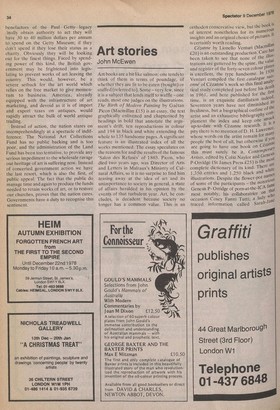Changing markets
Michael Wigan
Never before has the art and antique market been so much in the public eye. Apart from the startling escalation in saleroom prices, and the protest about the government's failure to preserve our art. heritage, it is the radical transformation in the marketing of antiques which merits wider comment.
Institutions and companies buying blocks of antiques for investment purposes are a modern phenomenon. The possibility of investing in a collection and then displaying it for advertising purposes is also alive. It is an attitude which raises many questions. The aesthetic value of art pieces is immediately translated into monetary values and, as if it were a stack of currency, the investment purchase is locked up in a bank vault, until such time as fashion, or just inflation, favour resale. The investment has as much intrinsic value for the investing institution as coffee does for a commodities broker. Yet its monetary value is decided by aesthetic, artistic and historical factors, none of which, from the moment of its concealment, ,get appreciated by anyone.
Moreover it is quite possible that the a priori motivations for investment buying are misconceived. The Select Committee of the Wealth Tax Report asserts that investment buying offers no cast-iron cer tainty of profit. The market is man's-land of pitfalls and booby tralis' Fashion and taste change: internab°11: politics can also play a key role. In We economic climate of the Fifties, for exattl,, pie, investors bought English silver, 'Ale," started a boom as fast in its rising as in waning. People were stranded withsoc,: which suddenly lost its value. SimilarlY the early Seventies the Japanese switche from buying Impressionist paintings to blir ing Oriental porcelain. The price of °rico' tal porcelain soared, and the Portuguese' using money from the sale of strip lancl„tier development, were buying 11",,desperadoes; private investors started reel'e less purchases on a portfolio basis. At the less of the fever there was a revolution11; Portugal and the biggest individual buYe was imprisoned, the Japanese realised till had overspent and could not get credit, lie private investors began withdrawing. 1",d Oriental porcelain market collapsed, 4ce one company, which had bought the entil, equity in Moss (a major porcelain dealer' subsequently went into liquidation. L.: rely The art trade in general are jiy opposed to investment buying, Princi1, because it takes the goods out of eld culation. They produce no income, It with bank rates and inflation to fly accounted for, investment buying clej.to needs very specialised guidance if it 'fits be preferred to the more obvious belle of land and property dealing. Foreignees arrived in force in London auction botrst when the pound was first floated aga'tlitis other European currencies. The itriPe tly initiated then, when Europeans could h t, so cheaply in Britain, has not been Ira . the thing the interesting, and astonislniZe thing in the longer term has bee°, the survival, in fact the flourishing, al London art market as a freenultdon Since it moved from Europe to Lot:..,,,t1 between the wars that market never 7,,,s so healthily enshrined as here, Sotbe'v's, and Christies are enjoying halcyon datils. and antique shops spring up like Po hrooms. Expertise about things 0i 1.,rt.. past seems to come naturally to the ish. Knowledge and experience are essots tial in assessing and understanding 14 of art, and the world experts, bY hi lLaorgned,onare and thedtheaelerss and collectorsthe museums and auction hpoeucsiaesli.sAts stiall°P:c! approval from the top dealers of the ;ention houses certifies an article's atlit, is ticity; and by identification a veliti determined. ld fe'ars But at this moment the art Wor° the VI several possible developments. benefactors of the Paul Getty legacy :Malty obtain authority to act they will have 30 to 40 million dollars per annum to spend on the Getty Museum; if they don't spend it they lose their status as a charity. Obviously they will be looking out for the finest things. Faced by spending power of this kind, the British government may be frightened into legislating to prevent works of art leaving the country. This would, however, be a severe setback for the art world which relies on the free market to give momentum to business. America, already equipped with the infrastructure of art marketing, and devoid as it is of import and export taxes on antiques, would rapidly attract the bulk of world antique trading.
Instead of action, the nation stares on incomprehendingly at a spectacle of indifference, The National Art Collections Fund has no public backing and is too poor, and the administration of the Land Fund has been too tentative, to provide any serious impediment to the wholesale ravage our heritage of art is suffering now. Instead of concerted government action we have the last resort, which is also the first, of public appeal. The fact that the public do manage time and again to produce the funds needed to retain works of art, or to restore our churches, proves that the nation cares. Governments have a duty to recognise this sentiment.















































 Previous page
Previous page